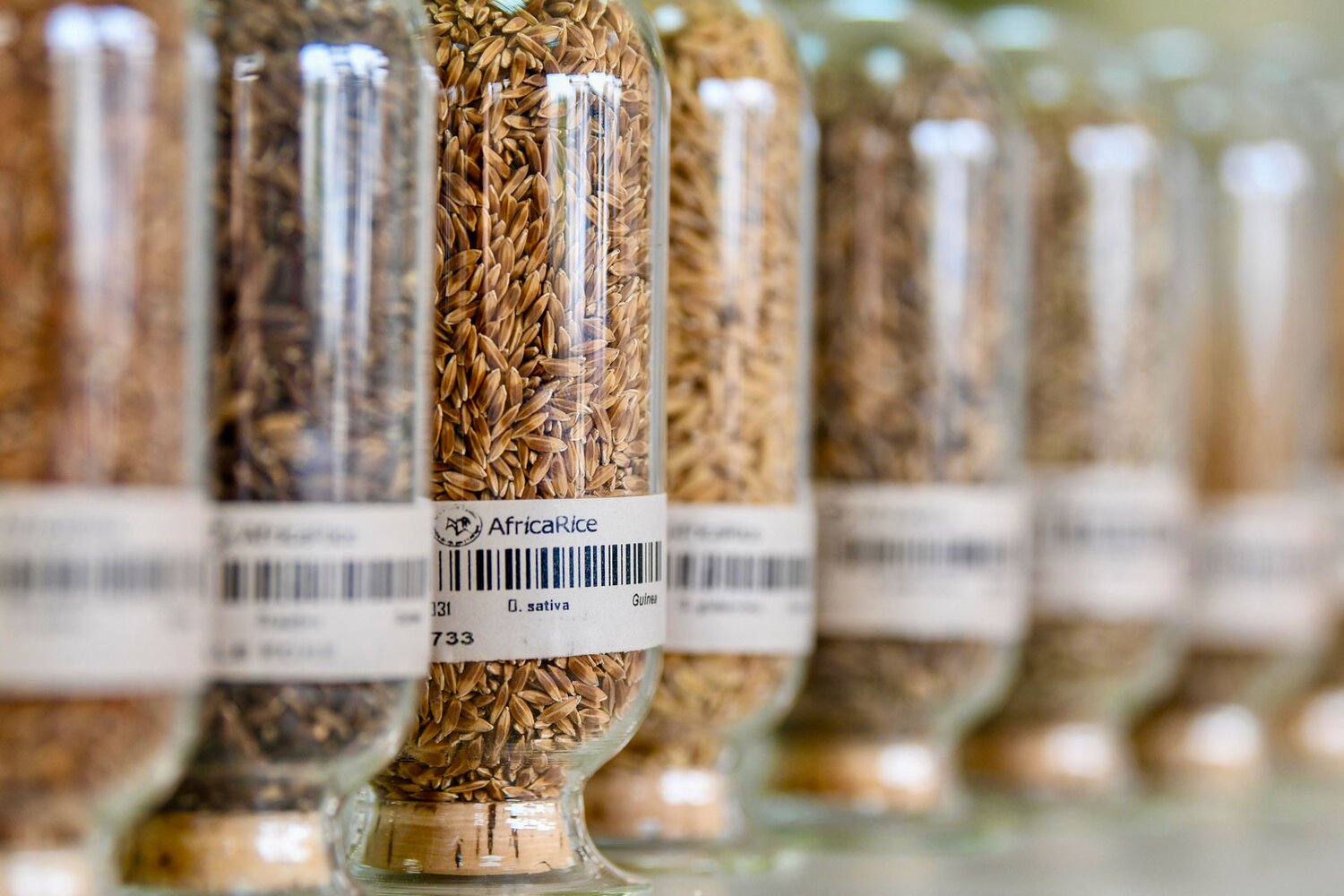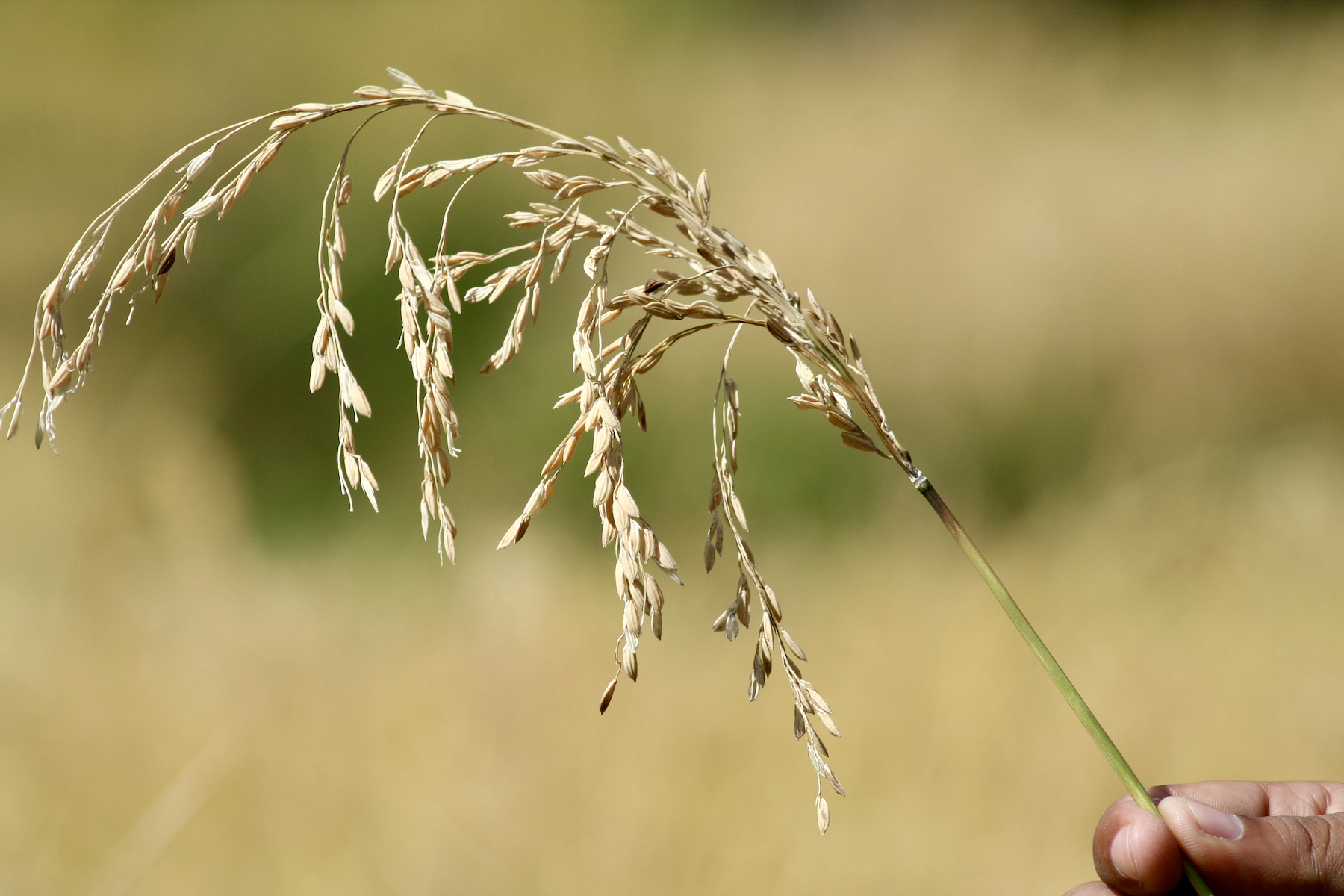Asian Rice/African Rice
Why rice?
Together with maize and wheat, rice supplies more than 42% of the calories of the human diet globally. Rice (Oryza spp.) is a staple food for about half of the world’s population. It is grown commercially in more than 100 countries on all continents except Antarctica, although the great majority of production and consumption is in Asia.
It is grown in both tropical and temperate regions, in both rainfed and irrigated systems. Two Oryza species are cultivated: O. sativa L. grown worldwide, and O. glaberrima Steud., grown mainly in West Africa but also in small pockets in Latin America.
Asian rice (O. sativa) contains two groups: japonica, grown in cooler zones of the tropics and temperate zones; and indica, grown in tropical and subtropical regions.
What we achieved
Collecting
- 318 seed samples of 15 species of wild rice collected in 12 countries: Brazil, Costa Rica, Ecuador, Ghana, Kenya, Malaysia, Nepal, Nigeria, Pakistan, Sudan, Uganda and Vietnam.
- Teams in Brazil, Ecuador and Costa Rica collected Oryza grandiglumis, a perennial wild rice endemic to tropical America that tolerates flooding and is high yielding.
- Partners collected Oryza longistaminata, a perennial African wild rice that is resistant to stem borers.
- Collectors in Pakistan found Oryza coarctata, an Asian rice that can cope with high salinity.
- Collecting teams in Nepal collected Oryza meyeriana, a wild relative of Asian rice that is resistant to bacterial blight, one of the most serious diseases in rice cultivation.
Pre-breeding and evaluation
- More than 1,500 introgressed lines (ILs) were developed from crosses between rice crop wild relatives (CWR) and cultivated varieties of O. sativa (Asian rice).
- All 1,500 ILs were genotyped, identifying which portions of the genome, and how much of the genome, have been inherited from the wild relatives.
- Promising ILs derived from wild Oryza species were identified with tolerance of drought, acid sulfate soils and saline rainfed conditions and for early maturity when direct seeded.
- Promising ILs have been conserved in the International Rice Genebank for sharing with global users through SMTA.

Project partners
Collecting
- Embrapa Genetic Resources and Biotechnology, Brasília, Brazil
- Universidad de Costa Rica, San José, Costa Rica
- Instituto Nacional de Investigaciones Agropecuarias, Estación Experimental Santa Catalina, Diego Mejia, Quito, Ecuador
- Plant Genetic Resources Research Institute, Accra, Ghana
- Kenya Agricultural and Livestock Research Organization, Nairobi, Kenya
- Malaysian Agricultural Research and Development Institute, Serdang, Malaysia
- National Agriculture Genetic Resources Centre of the Nepal Agricultural Research Council, Khumaltar, Kathmandu, Nepal
- National Centre for Genetic Resources and Biotechnology, Ibadan, Nigeria
- Plant Genetic Resources Program, Bio-Resources Conservation Institute, Islamabad, Pakistan
- Agricultural Plant Genetic Resources Conservation and Research Centre (APGRC), Wad Madani, Sudan
- Plant Genetic Resources Centre, Entebbe, Uganda
- Plant Resources Center, Hanoi, Vietnam
Pre-breeding and evaluation
Lead Institute: International Rice Research Institute, Los Baños, Philippines
Partners:
- Department of Plant Breeding and Genetics, Cornell University, Ithaca, New York, USA
- Mekong Delta Development Research Institute
- College of Agriculture, Can Tho University, Can Tho, Vietnam
- Vietnamese Seed Centers and Extension Centers
- Seed Clubs/farmers
- Northern Mountainous Agriculture and Forestry Science Institute, Vietnam
- South Center for Variety Evaluation and Seed Certification
Rice key collections, materials and data
Rice collections
- The largest rice collection is conserved at the International Rice Research Institute in the Philippines.
- Of the 318 seed samples collected, 249 samples are stored in the Millennium Seed Bank (December 2021).
- The Genesys PGR database also includes information about rice accessions in genebanks worldwide
Pre-breeding materials
- All pre-breeding materials and promising introgession lines are conserved in the International Rice Genebank maintained by the International Rice Research Institute in the Philippines
Data
- All data from the CWR rice pre-breeding and evaluation projects are available in the Germinate rice database
Rice stories
Crop Trust stories
-
Early Flowering African Rice Beats the Heat. https://www.croptrust.org/news-events/news/early-flowering-african-rice-beats-the-heat/. 5 July 2022.
-
Farmers know best: Developing salt-tolerant rice in Vietnam’s Mekong Delta. https://www.croptrust.org/blog/farmers-know-best-developing-salt-tolerant-rice-in-vietnams-mekong-delta/. Published 23 June 2021.
-
A little wild in our rice. https://www.cwrdiversity.org/rice_in_vietnam/. Published 8 January 2020.
-
Find them if you can: Searching for wild relatives in Central America. https://stories.cwrdiversity.org/story/searching-for-crop-wild-relatives-in-central-america/.
-
In Vietnam: Farmers evaluate wild rice-derived lines. https://www.croptrust.org/blog/in-vietnam-farmers-evaluate-wild-elite-rice-lines/. Published 31 July 2019.
-
Sunset of a population. https://www.cwrdiversity.org/sunset-of-a-population/. Published 6 April 2018.
-
Tigers, elephants and wild rice. https://www.cwrdiversity.org/tigers-elephants-and-wild-rice/. Published 4 December 2017.
-
Resilient Rice. https://www.croptrust.org/news-events/news/resilient-rice/. 10 October 2013.
Partner stories
-
In search of rice’s wild relatives [in Norwegian]. https://www.bistandsaktuelt.no/nyheter/2018/pa-jakt-etter-risens-ville-slektninger/. Published 16 February 2018.
- Wild relatives crossing continents. https://www.kew.org/read-and-watch/wild-rice-crossing-continents. Published 7 November 2019.
- Testing 30 rice lines for adapting to climate change in Bac Lieu province [in Vietnamese]. https://nongnghiep.vn/thi-nghiem-30-bo-giong-lua-thich-ung-bien-doi-khi-hau-tai-bac-lieu-d272410.html. Published 4 September 2020.
- Successful trial of many drought tolerant rice lines [in Vietnamese]. https://nongnghiep.vn/thi-nghiem-thanh-cong-nhieu-dong-lua-chiu-han-d280630.html. Published 23 September 2021.
Relevant publications
- Arbelaez, J.D., Moreno, L.T., Singh, N., Tung, C-W., Maron, L.G., Ospina, Y., Martinez, C.P., Grenier, C., Lorieux, M., McCouch, S. 2015. Development and GBS−genotyping of introgression lines (ILs) using two wild species of rice, O. meridionalis and O. rufipogon, in a common recurrent parent, O. sativa cv. Curinga. Molecular Breeding 35(2): 81. https://doi.org/10.1007/s11032-015-0276-7
- Kim, H., Jung, J., Singh, N., Greenberg, A., Doyle, J.J., Tyagi, W., Chung, J-W., Kimball, J., Sackville Hamilton, R., McCouch, S.R. 2016. Population dynamics among six major groups of the Oryza rufipogon species complex, wild relative of cultivated Asian rice. Rice 9: 56. https://doi.org/10.1186/s12284-016-0119-0.
- Boateng, S.K., Aboagye, L.M., Egbadzor, K.F., Darko, R.K., Ameka, G.K., Ekpe, P., Kanton, R., Dogbe, W., Saaka-Buah, S. 2019. Collecting of crop wild relatives and minor crops in Ghana. Research in Agricultural & Veterinary Sciences 3(2): 89–95.
- Medeiros, M.B., Valls, J.F.M., Abreu, A.G., Heiden, G., Ribeiro-Silva, S., José, S.C.B.R., Santos, I.R.I, Passos, A.M.A., Burle, M.L. 2021. Status of the ex situ and in situ conservation of Brazilian crop wild relatives of rice, potato, sweet potato, and finger millet: Filling the gaps of germplasm collections. Agronomy 21: 638. https://doi.org/10.3390/agronomy11040638.
- Tin, H.Q., Loi, N.H., Bjornstad, Å., Kilian, B. 2021. Participatory selection of CWR-derived salt-tolerant rice lines adapted to the coastal zone of the Mekong Delta. Crop Science: 61: 277–288.
- Tin, H.Q., Loi, N.H., Labarosa, S.J.E., McNally,K.L., McCouch, S., Kilian, B. 2021. Phenotypic response of farmer−selected CWR−derived rice lines to salt stress in the Mekong Delta. Crop Science: 61: 201–208.

